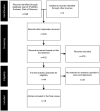Syndromic Surveillance Systems for Mass Gatherings: A Scoping Review
- PMID: 35457541
- PMCID: PMC9026395
- DOI: 10.3390/ijerph19084673
Syndromic Surveillance Systems for Mass Gatherings: A Scoping Review
Abstract
Syndromic surveillance involves the near-real-time collection of data from a potential multitude of sources to detect outbreaks of disease or adverse health events earlier than traditional forms of public health surveillance. The purpose of the present study is to elucidate the role of syndromic surveillance during mass gathering scenarios. In the present review, the use of syndromic surveillance for mass gathering scenarios is described, including characteristics such as methodologies of data collection and analysis, degree of preparation and collaboration, and the degree to which prior surveillance infrastructure is utilized. Nineteen publications were included for data extraction. The most common data source for the included syndromic surveillance systems was emergency departments, with first aid stations and event-based clinics also present. Data were often collected using custom reporting forms. While syndromic surveillance can potentially serve as a method of informing public health policy regarding specific mass gatherings based on the profile of syndromes ascertained, the present review does not indicate that this form of surveillance is a reliable method of detecting potentially critical public health events during mass gathering scenarios.
Keywords: disaster management; emergency medicine; infectious disease surveillance; mass gathering medicine; public health surveillance; syndromic surveillance.
Conflict of interest statement
The authors declare no conflict of interest.
Similar articles
-
Syndromic surveillance during religious mass gatherings, southern India 2015-2018.Travel Med Infect Dis. 2022 May-Jun;47:102290. doi: 10.1016/j.tmaid.2022.102290. Epub 2022 Mar 3. Travel Med Infect Dis. 2022. PMID: 35247579
-
An Observational Study Using English Syndromic Surveillance Data Collected During the 2012 London Olympics - What did Syndromic Surveillance Show and What Can We Learn for Future Mass-gathering Events?Prehosp Disaster Med. 2016 Dec;31(6):628-634. doi: 10.1017/S1049023X16000923. Epub 2016 Sep 19. Prehosp Disaster Med. 2016. PMID: 27641930
-
Harnessing Syndromic Surveillance Emergency Department Data to Monitor Health Impacts During the 2015 Special Olympics World Games.Public Health Rep. 2017 Jul/Aug;132(1_suppl):99S-105S. doi: 10.1177/0033354917706956. Public Health Rep. 2017. PMID: 28692391 Free PMC article.
-
Utility of emergency call centre, dispatch and ambulance data for syndromic surveillance of infectious diseases: a scoping review.Eur J Public Health. 2020 Aug 1;30(4):639-647. doi: 10.1093/eurpub/ckz177. Eur J Public Health. 2020. PMID: 31605491 Free PMC article.
-
Effectiveness of Public Health Digital Surveillance Systems for Infectious Disease Prevention and Control at Mass Gatherings: Systematic Review.J Med Internet Res. 2023 May 19;25:e44649. doi: 10.2196/44649. J Med Internet Res. 2023. PMID: 37204833 Free PMC article.
Cited by
-
Participatory disease surveillance for a mass gathering - a prospective cohort study on COVID-19, Germany 2021.BMC Public Health. 2022 Nov 14;22(1):2074. doi: 10.1186/s12889-022-14505-x. BMC Public Health. 2022. PMID: 36376856 Free PMC article.
-
Syndromic surveillance during 2022 Uganda Martyrs' commemoration.PLOS Glob Public Health. 2024 Jan 25;4(1):e0002068. doi: 10.1371/journal.pgph.0002068. eCollection 2024. PLOS Glob Public Health. 2024. PMID: 38271379 Free PMC article.
-
Animal health syndromic surveillance system in Jordan, a road map for a pilot model.Front Vet Sci. 2025 May 30;12:1538347. doi: 10.3389/fvets.2025.1538347. eCollection 2025. Front Vet Sci. 2025. PMID: 40520423 Free PMC article.
-
Influenza Epidemic Trend Surveillance and Prediction Based on Search Engine Data: Deep Learning Model Study.J Med Internet Res. 2023 Oct 17;25:e45085. doi: 10.2196/45085. J Med Internet Res. 2023. PMID: 37847532 Free PMC article.
References
-
- Henning K. Overview of Syndromic Surveillance What Is Syndromic Surveillance? MMWR Morb. Mortal. Wkly. Rep. 2004;53:5–11. - PubMed
-
- Samaras L., García-Barriocanal E., Sicilia M.-A. Innovation in Health Informatics. Elsevier; Amsterdam, The Netherlands: 2020. Syndromic Surveillance Using Web Data: A Systematic Review; pp. 39–77.
Publication types
MeSH terms
Grants and funding
LinkOut - more resources
Full Text Sources


